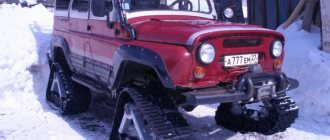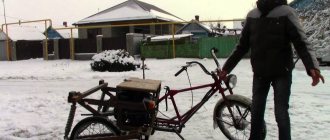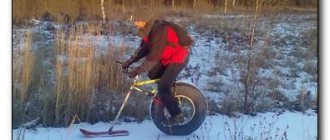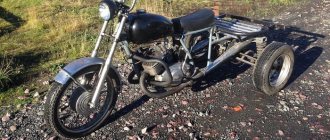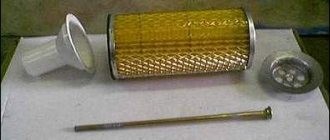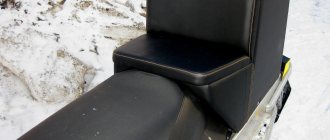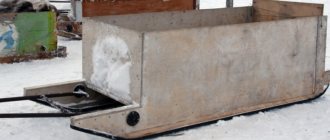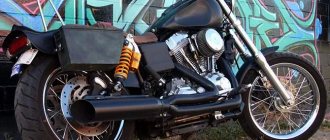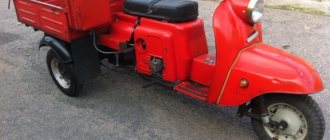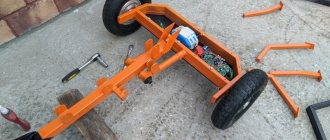As you know, there are many ways to develop homemade snowmobile skis. Strictly speaking, the ski includes a base, a shock-absorbing element, a fork, a shaft, link legs and a bipod for the fork. In some designs, for strength, the amplifier and, accordingly, the ridge are welded.
Homemade skis can be made from plastic pads. Therefore, expanders are bought in a specialized store, which are attached to the snowmobile chassis using a homemade fastening. For example, you can easily make a small homemade snowmobile with plastic skis. Why small sizes? – such a snowmobile will not weigh much, which means the load on the skis will be minimal. These miracle “machines” are an engine from Soviet mopeds on a frame where a seat is mounted.
Metal skis are much more difficult to manufacture, much less implement on a snowmobile. To develop metal skis you will need:
- Dye.
- Bolts and screws to secure all elements.
- Hydraulic pipe.
- Metal pipe with a diameter of 6 mm.
- Polyethylene pipe with a diameter of 85 mm.
Parameters of the future ski track: length – 1000 mm; width - 25 mm. These skis are ideal for both small snowmobiles and large equipment such as utility snowmobiles. The weight of one ski will reach about 7 kg. Before starting the main work, it is extremely important to shape the skis. To do this, use a cardboard stencil. Cut out the shape directly and create a bend in front of the ski. The bend angle is at the discretion of the future owner of these skis. If you go too far with the bend, the ski track will not slide on the snow, but will collect it and thereby slow down the equipment. To prevent the skis from bending upon first contact with a stone or stump, a pipe is welded along the edges. The so-called stiffener will strengthen the structure. At the bend, the pipe must be welded strictly along the contour. Next, we create a platform for the shock-absorbing system. Its installation is carried out with bolts to the skis. The connection of the platform with the bow of the homemade skis is carried out thanks to a hydraulic pipe. Thus, the upper component of the ski track is completed.
The lower part will be created from the ridge. To do this, we fasten the hydraulic pipe at four points. Before final fastening, the pipe must be compressed. After this, we fasten the polyethylene pipe using self-tapping screws. In order for the pipe to fit perfectly on the metal base, it needs to be straightened. To do this, it will be enough to cut it. A good alternative to a polyethylene pipe is a polypropylene pipe. They are used when laying sewers. True, sewer pipes are afraid of low temperatures. The final stage is painting homemade skis.
Hanging equipment
To make a snowmobile fast and strong, you need to put a good engine on the frame.
If you install a low-power motor, then such a structure will move poorly. You also need to correctly calculate the caterpillar. If the area is too small, it will sink in large snow and will not pull even on flat terrain. Particular attention should be paid to skis, which should create good stability and safety when moving at high speed
DIY rubber caterpillar
To easily move through the snow, it is very important to give your homemade snowmobile a good rubber track. It is not easy to make such a device with your own hands and it is better to purchase it in a store completely with rollers
Installing a standard factory track on a homemade structure is not difficult. To do this, you just have to secure the drive shaft and rollers with bearings to the frame. If your financial situation does not allow you to buy the entire device, then the most expensive parts can be easily made yourself. For this you will need:
- Conveyer belt.
- Plastic pipe.
- Bolts, washers and nuts.
A cheap homemade snowmobile track is usually made using a thin conveyor belt. To do this, plastic pipe blanks are sawed off to fit the width of the rollers. Then they are cut lengthwise into two equal parts and holes are drilled for small bolts. After this, the halves of the plastic pipes are secured to the conveyor belt with bolts, washers and nuts. The caterpillar is ready and further construction needs to begin.
Homemade skis
It's no secret that in winter it is much more convenient to travel on deep snow on skis. They also serve well as a control device on a snowmobile. It is not difficult to make a wooden structure, but only strong boards made of birch or oak are suitable for this. They need to be well dried, planed, and then heated and the ends bent. It's no more difficult to make metal skis. To do this, you will need to cut two plates from sheet steel and weld a thin corner on the sides.
In order for the skis to turn freely, metal pipe stands are welded to them. In working condition, they are held in the front bushings of the frame, where they rotate easily.
The steering wheel itself is easy to make with your own hands, or it’s easier to remove it from an old motorcycle. Thus, all that remains is to install the motor, as well as the driver’s seat, and you can hit the road.
Characteristics
As for the characteristics of the linings, the main one is width.
Some types are narrow - they are, in fact, ordinary dilators. If they are wider than the standard ones, it is not by much.
Wide overlays, which are expanders, are also produced. Their width is usually above 250 mm. Length and height are not such important parameters, although length affects the support area, which results in cross-country ability. As an example, let's look at extenders for snowmobiles from different manufacturers. Let's take domestic snowmobiles "Taiga" and foreign "Yamaha".
Models designed for both plastic and metal skis are produced for Taiga. But the products produced are more expanders, since their minimum width is 250 mm. Additionally, they are made quite long - from 1050 mm.
For Yamaha, the situation is approximately the same, but more plastic covers are produced. Their width and length are almost the same as products for “Taiga”.
That is, it’s quite easy to guess the linings based on the model - you just need to know the overall dimensions, and minor inconsistencies can be removed by heating and giving the desired shape. But when it comes to universal products or snowmobiles, which are rare and have a special design, the situation is more complicated.
Frame and body
Before work, it is recommended to draw up a drawing of the frame. The structure is welded from a square pipe 25 x 25 mm with a wall thickness of 2 mm. For a payload of over 150 kg, the section size is increased to 30 x 25 mm. The loading area and body elements are covered with plywood. The seats are selected with a hydrophobic coating.
In the center of the fracture frame there is a hinge that allows rotation around a vertical axis. The maximum rotation angle is limited by welding metal plates. The front half is used for steering, and the engine is placed on the rear half frame.
The solid frame is welded in the form of a rectangle, inside of which axles and tracks are located. The engine is placed in front on a special platform, rigidly welded to the rest of the frame. In both cases, the motor is installed in the transverse direction (the shaft faces the end).
How to make a snowmobile
You can make a snowmobile from different vehicles that are in the garage.
From a motorcycle
You can make a snowmobile from a motorcycle using different models. The most popular are IZH and Ural. The advantages of such a rework are that no special changes need to be made. If the product is in good condition, you can even keep the original frame.
The conversion technology is as follows:
- Make a rectangular frame from metal pipes or appropriate corners. Its optimal dimensions are 150*43.5 cm.
- In addition to the IZh motorcycle, it is necessary to make a steering beam. It is made from metal corners. The optimal dimensions are 50*50*5 mm. Additionally, the beam is sheathed with metal plates.
- After this, it can be installed horizontally on the drilling machine. Treat the connection area. Do the same with the frame. In these places you need to make special grooves for reliable fixation. Additionally, attach a corner to the front frame.
- Now you can attach the seat for motorcyclists.
- You need to make holes in the side members.
- A channel must be placed between the front and middle parts of the frame to strengthen the structure.
- Regardless of whether the snowmobile is made from a Ural or another model of motorcycle, it is necessary to select a track sprocket and rubber band in advance. The optimal dimensions are 220*30 cm with a thickness of no more than 1 cm.
- Before installation, it is recommended to cover the track with nylon, which will allow the material not to delaminate during operation.
- Now you can move on to the transmission. It consists of two parts. The first, the front axle, is the drive axle. It is made of a tubular shaft, a track sprocket and a roller. The second is the rear axle. It is made from a caterpillar drum and a tubular shaft.
- You need to complete the snowmobile manufacturing process by welding sheet metal skis.
When converting a motorcycle into a snowmobile, it is important not to change the steering system. In the final product, this part must perform its original functions
The principles of modification are the same, they do not depend on the vehicle model. But the snowmobile from the Ural motorcycle will be heavier.
From Zhiguli
The design of the car is characterized by simplicity, ease of operation and high maneuverability. To make it you need to follow the instructions:
- Frame assembly. It's better to make it from pipes. The frame consists of front and central beams (steel pipes with a diameter of 5 cm), two lower diagonal elements (bent pipes with a diameter of 3 cm) and a rear strut. Welding is used to fix the elements.
- Installation of steering columns. To do this, you need to place two bushings on the front beam.
- Fixing the axle shaft. It is located on the rear frame; first you need to weld the body under it. It is made from a metal pipe with a diameter of 6 cm. Secure the axle shafts using bushings and electric rivets.
- Installing a car engine. First you need to make the front and rear fastening units on the central beam of the frame. First they need to be placed on the engine itself, and only then welded to the frame.
- In a homemade snowmobile, you can install large diameter wheels or skis made of sheet metal. In the first case, the rear and front wheels need to be connected in pairs with a metal pipe. At the same time, make grooves in the hub for the bearings, which are subsequently secured with spring rings. Additionally, install a spacer between the bearings.
- Install a sprocket on each wheel depending on the expected maximum speed. This snowmobile can be used at any time of the year. For a snowy winter, a design in which the front wheels are replaced with skis is suitable.
- Installation of the steering system. It is taken whole from a car, for example, from a Zaporozhets, or a motorcycle. The choice depends on personal preference. In the first case, gas, clutch and brake pedals are additionally installed. The gearbox is controlled using a lever and a rigid rod.
- Installation of a snowmobile cabin, the role of which is played by the car body.
Snowmobiles sold in stores have a fairly high price and often do not fit into the budget. But you still need to move in the snow. Fishing, hunting and just active recreation in the wild require cross-country ability. Therefore, we will look at ways to make a snowmobile with your own hands.
Snowmobile from motorcycle
The first model was assembled at a service station from scrap parts, plus a little welding. The engine is from a Voskhod 1 motorcycle, the sled is welded from metal pipes.
Homemade snowmobile skis – MotoSneg
Snowmobile skis? it's like shoes for a person. They not only allow the car to move, but also take all the impacts on themselves.
Snow ? not only a lightweight flooring, it is also a sharp tool, often hiding hummocks, stumps and boulders underneath. Do-it-yourself snowmobile skis can be made from various materials that are at hand.
They are designed to withstand a certain load. It is calculated separately for each car.
Types of snowmobiles and parts for them
Before you buy a snowmobile or make one yourself, it is important to decide what specific task it will perform. All machines of this type are divided into the following types:
- mountain;
- tourist;
- sports;
- utilitarian;
- children's;
- mini snowmobile.
As a rule, they differ from each other not only in size, but also in the width of the leading caterpillar.
Most often, snowmobiles on the market have two skis in front, which are attached to one suspension, it can be a lever or a spark plug.
They differ from each other as follows: the lever system is designed for easy control, but in the forest it can break from any stump; the candle system is worse in control, but is much more resistant to impacts.
Among Russian snowmobiles there are models with one ski in front and two tracks in the back. Such cars are suitable for driving on the highway and for maneuvering in the forest. The bad thing is that as the speed increases, they lose controllability. Models from different manufacturers may vary in width and shape.
Factory parts are standardly made of reinforced plastic. There are also metal skis. [ads-pc-1]
How to properly change snowmobile shoes
In some cases, the purchased car requires replacement skis. This can happen for several reasons:
- breaking;
- snowmobile modernization.
You have to replace it more often when it breaks. When replacing in the event of a breakdown, you can upgrade the snowmobile (or mini-snowmobile) using specially selected ski models. To do this, you need to know exactly what set of fasteners is needed. Upgrading a snowmobile doesn't always require new skis. Sometimes owners can easily make do with parts such as linings (extenders).
You can choose your own options for any car. Ski extensions are available in three types:
- for metal models;
- for plastic models, they have a groove along the entire surface;
- universal linings.
It is not always possible to select expanders the first time. Sometimes they don't fit the ski. If the problem is that there is a small gap left or the bend does not match, then it can be easily solved with your own hands. Some extensions are designed specifically for riding in the woods. By installing them, you can enjoy special cross-country ability and driving on loose snow.
Choosing between homemade and factory options
When it comes to this topic, the root of it lies in a financial problem or the inability to find a particular ski model. It is at this moment that a person thinks about whether he can make the necessary part with his own hands. Homemade options are also offered by craftsmen who easily make not only skis, but also snowmobiles themselves.
Of course, factory parts? this is the standard of quality. They are created for a specific model by experienced specialists, and snowmobiles on these skis are first tested in various conditions.
If the car is an expensive sports car, then it is better to purchase components for it from the factory.
How to proceed ? Buy a new model in a store or make everything yourself? The choice is up to the owner of the winter vehicle.
There are several manufacturing options: you can use tin, wood, plywood, old hunting skis and snowmobile extensions. [ads-pc-2]
Manufacturing process
Let's consider several options for making skis with your own hands. First, let's determine what this part should consist of. Typically, a ski consists of a base, a shock absorber, a link leg, a fork, its rod and a bipod. Also, sometimes an amplifier is welded and an additional ridge is installed.
First DIY option? skis based on plastic linings. To do this, purchase expanders from the store and install homemade connections to the suspension. One of the simplest models of snowmobiles is a mini snowmobile. An old moped is used for it, including the engine and frame with a seat. Any skis are suitable for this option, as the design is lightweight.
The second option is somewhat more complicated. It involves making skis from metal. The required bend is determined by the owner himself.
So, initially you will need the following materials: a metal sheet 3–4 mm thick, a piece of hydraulic pipe, a 6 mm pipe for rigidity, a polyethylene pipe with a diameter of 85 mm, bolts, screws, metal for the mounting area, paint.
The length of one ski should be calculated taking into account the bend. As a standard, it is at least 1 m. The width of the sheet can be determined as 20–25 cm.
These skis will fit a mini snowmobile, but they will be strong enough for other models. The weight of one such ski will be about 7 kg.
The work begins with determining the shape of the ski. To do this, it is better to use a stencil pre-made from cardboard. Then the shape itself is cut out and bent to the bend desired by the owner. Curving the nose too much will collect snow rather than push it away.
A stiffening rib from a 6 mm pipe is spot welded along the edges of the ski. Towards the nose it should connect with the second rib, repeating a smooth contour. Is the suspension platform now made separately? it is attached with screws to the ski. The platform is connected to the nose by an arc with a bend made of a hydraulic pipe.
The upper part of the base of one ski is ready.
Work on the lower part begins with the skate. To do this, take a hydraulic pipe and bolt it in four places. The skate must be firmly secured. The pipe is first compressed at the attachment point.
Now you need to attach the straightened polyethylene pipe with self-tapping screws. It is pre-cut lengthwise. Sometimes it is advised to use polypropylene sewer pipes instead, but they become very fragile in cold weather, which cannot be said about polyethylene.
After the ski, you need to paint it and think about what to make the suspension out of.
My homemade snowmobile with rubber tracks was capable of moving not only on shallow snow, but also on almost any off-road terrain.
Then it will be possible to drive not only on compacted snow, but also on open ground.
Snowmobile design
Such engines have a gearbox that reduces speed by half and an automatic clutch in an oil bath. They are used on mini-tractors, walk-behind tractors and other garden equipment.
When making my snowmobile, I took some components and parts from the Buran snowmobile: a caterpillar track, two pairs of bogies with four rollers, a caterpillar driven shaft assembly and drive sprockets.
I bought all this in stores that sell spare parts for snowmobiles.
A rear pendulum with a driven shaft and rollers supporting the track (wheels from a children's scooter) was attached to the resulting balancer of two bogies.
Reference by topic: DIY snowmobile
Manufacturing of racks
If you drive a snowmobile only on loose snow, then the attachment of skis to the racks can be made rigid. With such a suspension, the snowmobile will be more stable on loose snow.
I used coil springs for the suspension, which are installed on the bogies of the Buran snowmobile. They are on sale and inexpensive. The stiffness of two springs on each ski is quite enough.
How to make a snow scooter with a chainsaw engine with your own hands
To make a children's gas snowmobile with your own hands, you can take the motor from a chainsaw. For example, common options:
“Friendship” is simple, the device will be without unnecessary details. At the same time, the weight is 12 kg, and the power is small - 1 kW
Another disadvantage is that there are no safety covers, which is especially important for children. “Ural” - the weight is approximately the same (almost 12 kg), while the power is much greater - 3.6 kW. The engine is two-stroke and works even in cold weather. “Shtil” is a saw of medium power, but it is not so noisy
It does not produce strong emissions, which is also important for children.
Required materials and tools
To make a snow scooter with a motor with your own hands, you will need ready-made structures and installations: a gasoline engine, steering wheel, windshield, seat, chassis, shock absorbers. You can take a ready-made backrest for a snow scooter or make it yourself.
For work you need to prepare the following materials and tools:
- Welding machine with electrodes.
- Duralumin pipe D16.
- Bearings: 2 pcs. 16 mm each, 1 pc. – 10 mm.
- Plugs for plastic pipes – 2 pcs.
- Star element.
- Tracks 5 cm.
- Plywood, plastic or fiberglass (sheathing).
- Steel shafts.
- Pipe for frame with a diameter of 25 mm.
- Aluminum profile (letter “P”).
- Profile steel pipe with a cross section of 20*20 mm.
- Fastening elements (nuts, bolts).
Drawings and assembly diagram of a snow scooter
The easiest option is to take a ready-made children's snow scooter and mount the motor yourself. If you wish and have the necessary elements, you can assemble the structure yourself by taking the engine, steering wheel, making the chassis and other parts. You can take a ready-made drawing as a basis.
When assembling products with your own hands, you must follow safety regulations.
Step-by-step instructions for assembling a snow scooter with a motor consists of the following steps:
- First you need to make a frame. Using spot welding, a steel sheet 2 mm thick is connected in the middle of the entire structure. The chain drive shaft will be mounted here, as well as the gearbox.
- A seat is located in the middle of the frame. You can do this yourself - then you can save money on assembling a snow scooter with a motor yourself.
- The support base is fastened with a beam to the front axle crossbars. A water pipe with a diameter of 15 mm or more can be used as a connecting element. Bushings for the steering wheel are welded at the ends, and a stand is mounted in the middle.
- The next stage of assembling a snow scooter with a motor with your own hands is the stand. For installation, use steel corners with sides of 30*30 mm. They are connected by steel crossbars - 2 mm gussets are suitable for this. The motor will be mounted on this rack.
- The caterpillar is taken ready-made, for example, from the Buran snowmobile. The workpiece needs to be shortened by 50 cm. The caterpillar is secured with transport tape. And the gears are made from cardboard sheets 15 mm thick.
- The drive shaft is made of 14 mm thick pipe. The gears are fixed with the upper flange, and trunnions (tips) are welded behind the drive shaft.
- Now you need to attach the scooter motor. You can also do this with your own hands at home. To do this, take a working unit, weld it and mount it to the rear.
- To make sprockets, you need to take two tips, and the right one should be longer than the left one (to make a keyway that will fix the chain drive sprocket). The sprocket is secured with a pre-threaded nut.
- You can also make the snow scooter's steering wheel yourself. To do this, take a ready-made device from a bicycle or scooter. For proper installation, it is necessary to place it on the central axis so that the traction force controls the skis well.
- At the last stage, you can install a windshield, as well as headlights for illumination at night. It is not necessary to install the brakes yourself for a children's snow scooter with an electric motor or a gasoline engine, since the vehicle does not gain high speed. If necessary, you can always brake with your foot or release the gas.
A finished snow scooter with a motor, assembled with your own hands, is in no way inferior to the factory design
Manufacturing of structural elements
Before starting to manufacture structural elements, prepare a drawing, required materials and tools. You can take ready-made drawings based on the Bullfinch or Vepr snowmobiles. Tools you will need:
- welding machine;
- pipe bender or finished frame;
- hammer;
- screwdrivers.
Since the design of the mini snowmobile is low, the seat is made of durable waterproof material. The fuel tank is made of metal. Its volume should be from 10 to 15 liters. You can use a motorcycle chain as a drive.
How to make a snowmobile track
A snowmobile track is created from tires or conveyor belt. The work will be difficult and time-consuming if tires are used as the basis. The sides are cut out of them, so the work requires a sharp shoe knife or an electric jigsaw. To facilitate the process, tires are selected with a suitable tread pattern. Making a homemade caterpillar:
- The sides of the tire are cut out with a knife. If the knife blade is periodically moistened in a soapy solution, the cutting process will become easier. When using an electric jigsaw, install a blade with small teeth and moisten it with water.
- If, when cutting, the track turns out to be hard or extra layers have formed on the wrong side, they are also cut off.
- Cutting a new structure is done when there is a mismatch in the tread pattern. The structure made must cling to the soil, so the structure of the pattern must be correct.
A caterpillar made according to this design is quite reliable due to the fact that it has a closed loop. Its disadvantage is its narrow width. To make a larger size, it is doubled. If the caterpillar is made from a conveyor belt, then it is combined into a single ring. This can be done in 2 ways:
- like a piano hinge (with a hinge);
- ribbon stripes.
You need to choose the appropriate thickness of the tape if it is sewn on. Its thickness should be suitable for the engine power. A homemade snowmobile from an IZH motorcycle requires the use of a 10 mm thick tape. To increase the service life of the snowmobile, the edges of the conveyor belt are stitched with fishing line. The seams are made according to the method of overcasting the edges with an interval of 1 cm.
Tackles
A trolley is a movable platform that protects the chassis of equipment from unnecessary mechanical loads. The platform is used when it is necessary to drive a snowmobile into a garage. For its manufacture, a metal pipe of medium diameter (6×6 mm), rollers and a bearing system are used. The wheels are installed with rubber coating and metal discs. Their diameter must correspond to the weight of the equipment.
Snowmobile skis consist of a base, a shock-absorbing part, a rod, a fork and bipod, and a link leg. Skis can be made in different designs from different materials. If plastic linings are used for the base, they are supplemented with expanders. The extensions are mounted with fastenings to the snowmobile chassis. The plastic design is suitable for small equipment. For large and medium-sized snowmobiles, you will need metal skis.
- To give the skis a shape, cut out the base from a cardboard stencil. At the same time, a bend is formed in front. The amount of bending is done at your own discretion. A ski track with a large bend glides poorly and collects snow. And this creates unnecessary braking. Therefore, you should not make it too large. The approximate size of the ski track is 2.5 cm wide and 100 cm long.
- A pipe is welded along the edges of each part. This gives additional rigidity to the product and protects it from stones that come along the way.
- Where the bend passes, the pipe is welded along the contour.
- Shock-absorbing parts are fixed to the skis. Bolts are used as fastening elements.
- The platform and the nose of the skis are connected by a hydraulic pipe. The top part is ready.
- For the lower part, the hydraulic pipe is fixed at 4 points and compressed.
- Then the polyethylene pipe is attached with self-tapping screws, having previously cut it. Instead of a polyethylene pipe, you can use polypropylene.
How to make a caterpillar attachment for a walk-behind tractor
When assembling a snowmobile with your own hands, special emphasis is placed on the caterpillar track. Let's look at the features of assembling a homemade product: how to make a caterpillar attachment to a walk-behind tractor with your own hands.
Some craftsmen install parts from a walk-behind tractor or make them with their own hands, and those who cannot manufacture them purchase a universal factory caterpillar drive. A homemade caterpillar can be made from:
- bushing roller chain and conveyor belt;
- tires;
- belts
A homemade tracked attachment to a Buran series unit is often found. For such a unit, the entire chassis together with the engine weighs 20-30 kg.
The snowmobile attachment “CAM” for the walk-behind tractor is produced only in Nizhny Novgorod. It goes on 3 rollers and is all-terrain. It can be driven both in snow and mud.
For a homemade snowmobile there is also a prefix “CAM”, only in this case you will clearly need to know the shape and parameters of the gearbox shaft.
Crawler module for walk-behind tractor. Thanks to the wide tracks, this attachment can easily move through deep snow. It fits the Neva, Oka, Tselina, Cascade, Luch walk-behind tractors, and can also be used on walk-behind cultivators with some modification of the seats. In the finished console, you can adjust the tension of the tracks, which stretch when moving.
The driven part attached to the walk-behind tractor is also of no small importance. This is the driver's seat and luggage space
In this case, you can use whatever comes to mind: a board, a stool, a sleigh, a chair, etc. The only important condition when choosing is that the seat is waterproof.
Read also: What is masonry mesh used for?
Ready-made crawler attachment for the Neva walk-behind tractor. There are universal tracked attachments on sale that are suitable for any mini-unit, including the Neva walk-behind tractor. They are easy to assemble and install. Very compact and do not take up much space when stored. The optimal width of the tracks increases the maneuverability of the device. The risk of getting stuck in snowdrifts or mud is minimized. The undoubted advantage of ready-made tracks is their long service life and affordable price.
Varieties
They are made of frost-resistant plastic.
This ensures their low cost. They are produced in three types - for plastic skis, metal and universal. The difference between plastic and metal comes down to shape. For plastic ones, they are made with a deeper central groove, through which they are attached.
Because of this, using them on metal models is impossible, since its surface will not fit tightly in the gutter, which will result in a void. This may cause damage when moving.
In metal ones, the groove is not deep and narrower, so it won’t be possible to put it on a plastic one. Universal manufacturer's assurances are suitable for all models.
But there is one nuance in all this - if the expanders are designed for a specific model, this does not mean that it will fit into its place “like a glove.” When casting from plastic, the part may change shape slightly as it cools.
It should be added that it is also possible to change the geometry of the ski itself. Therefore, it is possible that they will not fit very tightly. If the gaps are small, they can be removed by heating the purchased product and then giving it the desired shape. But if the gaps are large, the situation will not be corrected in this way. This also applies to universal pads.
They may fit perfectly on some models, but on others they cannot be installed.
Homemade motorized dog: technology
Before starting work, you need to prepare all the necessary tools and equipment for the motorized dog. You can learn more about the progress of the work by watching the thematic video.
Preparing for work
To avoid problems with using a motorized dog, it is important to immediately determine its main technical parameters:
- load capacity;
- engine power;
- transmission type;
- engine starting system - manual or electric.
You should also think about additional accessories for the motorized dog - a winch, lighting, protective elements, seats. Then an accurate drawing is drawn up, which will reflect all the nuances. Next, you can order a set of parts for a motorized dog or select them yourself from those available from other equipment.
Required Tools
When working, you cannot do without a welding inverter, a drill and grinder, and a set of wrenches. Also, to install the motorized dog, you will need screwdrivers, a file, and other small tools. The craftsman must have access to lathes and milling machines.
Assembling a motorized dog
First, they make the frame of the motorized dog, which will help secure the engine, gearbox, and chassis. To do this, selected pipes (a beam or channel is also suitable) are welded into a rectangular frame. Then the fastenings for all the important components of the motorized dog are welded. Afterwards you can install the engine.
Photo gallery
The range of accessories for snowmobiles also includes ski covers. Which can increase the cross-country ability of winter transport in deep snow. We invite you to familiarize yourself with this accessory in our photo selection.
Why does the rear suspension need modification or replacement?
Whether a snowmobile needs tuning, in particular changes to the rear suspension parameters, is determined by the purpose for which the vehicle will be used.
Are there two types of snowmobile suspensions? connected and unrelated. A connected suspension has two main advantages:
- she shares the toughness;
- controls weight transfer if the vehicle picks up speed.
Often this type of rear suspension is installed in snowmobiles that will be used for sporting purposes or for transporting cargo. This is necessary in order to cope well with sharp turns, strong shaking and frequent redistribution of weight.
Unconnected pendants have their own characteristics. Their front and rear elements are independent. Therefore, if the front part deviates, the rear either deviates only a little or remains in place.
Unlinked harnesses are best attached to snowmobiles that are used in deep snow or have long tracks. They are more capable of increasing traction and also distribute weight well. Also, improving the performance of the suspension may be necessary if the snowmobile engine has been tuned. After all, in order for a vehicle to cope with new loads, a comprehensive modification is necessary, and the suspension in this case? not an exception.
First of all, suspension tuning includes replacing shock absorbers. The main types of shock absorbers for vehicle suspensions:
- simple shock absorber;
- telescopic shock absorber;
- shock absorber for enduro;
- shock absorber for crosses.
In case the main purpose of the snowmobile is? normal riding, then enduro shock absorbers are needed. They are applicable in production 440 Pro vehicles, but the price of such shock absorbers is also considerable. Shock absorbers for tuning sport snowmobiles are often equipped with additional volume gas chambers that allow them to be tuned for specific applications.
Also, the rear suspension often needs adjustment. The choice of adjustment level depends on what kind of physical load is planned for this vehicle, what the weight of the driver and passengers is, how the driver is used to driving the vehicle, what his personal preferences are, the speed mode and the condition of the roads. Each part of the rear suspension is responsible for specific functions. Therefore, in order to know what you will achieve by adjusting the suspension, you need to decide which part needs to be adjusted.
- The job of the rear springs is to ensure smooth movement.
- The purpose of the extension cord? provide reverse movement, taking into account the loads and condition of the snow paths.
- The shackle is adjusted taking into account the condition of the snow path and what the loads will be.
- How comfortable it will be to drive the snowmobile depends on the adjustment of the central spring.
- The tape limiter controls the redistribution of weight.
- Thanks to the shock absorbers, the snowmobile is easy to control and comfortable to ride and sit on.
What are the benefits of BRP snowmobiles?
Canadian company Bombardier Recreational Products (BRP) is one of the oldest and best in the industry. The range covers all types of snowmobiles. BRP is also well represented in our market.
The company has been producing snowmobiles under the well-known brands Ski-Doo and Lynx for more than 70 years and this is one of its main specializations.
The 2021 Ski-Doo snowmobile lineup consists of 29 snowmobiles in 9 families: motocross MXZ, crossover SUVs Renegade, mountain models for deep snow Summit, Freeride for extreme sports, luxury trail snowmobiles of the GSX series, tourist Grand Touring, tourist-utilitarian Expedition, light utility vehicles Tundra and classic transport vehicles Skandic. Power - from 85 to 165 hp, fuel tank volume - 36 to 45 liters, vehicle weight from 199 to 356 kg. Engines – 2-, 3-cylinder, 2-stroke and 4-stroke. Plus, a wide selection of spare parts, accessories, and branded equipment are available from the official BRP dealer.
The main new snowmobile models for 2021:
- turbocharged Rotax 900 ACE Turbo engines with 151 hp;
- new Rotax 600 ACE engine;
- upgraded SilentTrack II and SilentCobra WT tracks;
- information digital displays measuring 4.5 and 7.2 inches diagonally;
- improved cТMotion suspension.
Snowmobiles are divided into 5 groups:
- utilitarian or traction (transport);
- tourist;
- sports and crossovers;
- mountain;
Snowmobiles differ in:
- engine power;
- speed;
- maneuverability;
- cross-country ability (width, length of track);
- comfort;
- dimensions.
Utilitarian snowmobiles (wydtruck) are designed for transporting goods and have high cross-country ability. These are powerful and reliable machines with wide and long tracks. Usually double, comfortable, with a backrest, rear-view mirrors, a trunk, a towbar, and have reverse gear.
Tourist ones are also powerful and faster. Comfort, necessary for long trips, and cross-country ability come first.
Sports - the main thing is speed, light weight of the car, minimum comfort. They are equipped with a very powerful engine, energy-intensive suspension, narrow and short tracks (not for deep snow). Passability is not a priority.
Mountain snowmobiles are similar to sports ones, with a powerful engine, they also have a narrow, but much longer track (up to 4 meters) with large lugs, and are light weight. Weight distribution goes to the front. Very maneuverable due to low weight.
Step-by-step instruction
Before starting work, calculations are made of all design parameters, draw a diagram of the snowmobile on a sheet of paper, prepare all the parts and tools:
- wide ski up to 80 cm long;
- two small metal pipes with a cross section of 50 mm;
- a small piece of channel;
- a metal plate measuring 25x50 mm, thickness 4-5 mm;
- cameras from a KAMAZ vehicle;
- wrenches of different sizes;
- hammer;
- pliers;
- electric drill;
- welding machine.
The experts have established experimentally that for good performance and stability of the snowmobile, it is better to use pipes with a diameter of 40 mm and a profile of 25x25 mm, with a wall thickness of 2 mm.
Assembling the front part of the snowmobile
It’s best to start by replacing the front wheel with a ski to reduce friction with the snow. Making your own skis is not difficult.
To improve the quality of the structure, it is recommended to make skis from duralumin or chipboard.
- To do this, take 4 pieces of plywood with a thickness of 5 mm. Pieces of plywood are glued together and attached to the steering base.
- Then a spring made of high-strength steel is well secured to the structure. Instead of a homemade ski, an old skateboard or out-of-use factory skis are also used.
- The next step is to remove the front wheel of the bicycle. Then fasten the piece of channel in the center to the prepared ski - this is done using four M8 or M10 bolts.
- Then cut two pieces of pipe of the same size, attach them to the bicycle fork - one pipe for each arch of the bicycle. To make the structure strong, it is better to secure the pipes to the bicycle fork using clamps or clamps - use at least two fasteners for each fork arc.
- The pipes must be fastened symmetrically relative to each other. To make the structure durable, rigidity is added. To do this, through holes are drilled in the middle of the tubes, which are tightened together with bolts.
- The tubes attached to the bicycle fork bars are cut to be 20-30 cm longer than the bottom of the bicycle.
- The ski is mounted with a bracket. To do this, symmetrical holes are drilled on both sides of the channel. At the edges of the fork tubes, holes are made the same size as in the channel - no less than 11-13 mm. The structural element is connected with long M10-M12 bolts.
- To strengthen the frame at the joints of the parts, weld a transverse pipe to the bottom of the steering wheel. You need to attach the ski attachment to the transverse pipe using hinges.
- Using a washer, bushing, steel pin, and two nuts, assemble the hinge joint.
After all the operations have been completed, the ski is already installed on the bike - it moves vertically, which means the descent or ascent is made at any angle, just like on a bicycle.
Length of track and lugs
Which caterpillar is better: short or long? Ski-Doo's full-size snowmobiles typically feature tracks ranging from 121 to 159 inches (3073-4038 mm) long and 15 inches (381 mm) wide. The longer and wider the caterpillar, the larger the supporting surface of the snowmobile, which means the more cargo it can transport without “sinking” in the snow. At the same time, a short track with shallow lugs creates less resistance, thereby making the machine faster and more maneuverable. Therefore, most sports models are equipped with just such a caterpillar. Mountain models usually come with a long track and deep lugs so they can move more snow through the system, thereby providing better flotation in deep snow conditions. Tourist and utilitarian models are also produced with a long track, since they are all designed for more than one passenger.
The lug depth can range from 0.75 to 2 inches (19 -50 mm). The deeper the lugs, the more snow the track can handle, given that the snowmobile has enough power. But it is worth remembering that such lugs only perform well in off-road conditions; on a compacted track where the snow is hard, they will no longer be so good and can affect the handling of the snowmobile. They also increase resistance and thereby reduce speed. If your goal is a fast and maneuverable machine, we recommend choosing medium-length lugs.
Bindings and poles
For making fasteners
Various materials are used for hunting skis. They can be metal, fabric, leather, canvas or plastic. Each hunter selects the most comfortable option for himself individually. The classification of fasteners depends on the method of their fixation.
There are 4 main types of ski bindings
- Simple
. They are a sock loop into which your foot can be easily threaded. They are chosen most often, since attaching the mount to hunting skis is not difficult, and the diameter of the ring can be changed at your discretion (so that the foot can enter up to the 2nd phalanx on the big toe). - Soft
. In addition to the toe, the heel is also securely fixed. The foot is in a comfortable position, and the person does not experience discomfort when climbing or walking on loose snow. - Semi-rigid
. Semi-rigid bindings for hunting skis are available in the form of a hard plastic base equipped with two straps. One is responsible for fixing the forefoot, and the second – the heel. - Tough
. Used only for snowshoes, since this type of ski binding prevents slipping.
Usually people go on hunting skis in the forest without poles.
As a last resort, they use an ordinary walking staff, which hunters make themselves from durable wood. It helps not only to maintain balance, but also to check the depth of the snow cover.
Which snowmobile should a beginner choose?
When choosing your first snowmobile, you need to understand why you need it - just to ride, or to ride very quickly. Tourist or utilitarian - not so fast, but passable, powerful and heavy. It may be difficult for a beginner to control a heavy car at first, especially when cornering. Or you will quickly get tired of the monotony and slow driving. Sports and mountain snowmobiles will be more interesting for some - high speed, maneuverability. Even if you get stuck somewhere in the snow due to inexperience, such a car is easier to pull out even alone. That is, first of all, you need to decide on the type of snowmobile.
It is not necessary to immediately go into technical details - type of suspension, engine, type of cooling, what kind of transmission. The best option is to test drive different snowmobiles at a dealer or with friends. The most important thing is that you have to like it! Power shouldn't be an important criterion either.
You should pay attention to the ease of control, and the price
How to make your own snowmobile from a walk-behind tractor
For our country, a snowmobile is the best vehicle in winter. It is characterized by high maneuverability in snowdrifts, as well as good maneuverability. In addition, it has minimal fuel consumption.
You can find snowmobiles from different manufacturers on the market, but they are not cheap, and not everyone can buy them. Craftsmen have gotten the hang of making a snowmobile from a walk-behind tractor with their own hands. This requires the appropriate tools, parts, time and a little ingenuity. The standard kit for creating a snowmobile is:
- frame;
- engine;
- tank;
- seat;
- skis;
- steering wheel;
- caterpillars;
- drive unit.
The steering system of this vehicle is located in front. It is controlled by skis.
Let's look at how to make a snowmobile based on the Neva walk-behind tractor. In order to assemble such a machine, you first need a walk-behind tractor. It acts as a motor. In our country, the Neva walk-behind tractor with a Japanese engine and air cooling is very popular. There are a total of 8 models of this brand. The engine runs on gasoline, the power of which varies from 6 to 9 hp depending on the model. Speeds are switched by a chain gearbox. There are only four of them. The capacity of the fuel tank varies from 3 to 5 liters.
Due to its power, the Neva walk-behind tractor is ideal for conversion into a snowmobile. It is universal, since the engine power is enough to transport bulky cargo or several people. The walk-behind tractor can reach speeds of up to 60-80 km/h. There is a caterpillar attachment for sale for the Neva unit, which can be easily assembled and installed.
Let's figure out how to make a snowmobile for a walk-behind tractor with your own hands. First you need to develop a remodeling plan and clearly imagine what you have to do. The ideal option is to create a drawing from which calculations can be carried out accurately. If you are not good at drawing, then you can find ready-made drawings of previously manufactured snowmobiles, and having selected a more suitable option, start assembling.
For beginners in this business, it is recommended to create a small model that can be made from ordinary cardboard. To imagine a future device, it would be a good idea to consider other people’s already made models in order to have a better idea of the work ahead. There are many homemade snowmobile prototypes on the Internet.
The next step is to make a list of the necessary materials, parts and tools needed for the snowmobile. After purchasing everything you need, you can safely proceed to assembly. In general, it is better to divide the assembly of the walk-behind tractor into several stages, this will make it easier to cope with the task. The workflow looks something like this:
- Making the frame. The optimal solution is a ready-made motorcycle frame. If there is none, then durable pipes are used. Using a pipe bender, you can get a platform of the desired shape and, using a welding machine, connect the ends.
- Mounting parts. A support (bracket) is welded to the frame, to which the walk-behind tractor will be attached. Next comes the installation of the walk-behind tractor, seat and various parts: steering columns, shock absorbers, runners, etc.
You need to be very careful and pay special attention to the size of the parts. They must be executed clearly according to the diagram, otherwise the snowmobile attachment to the walk-behind tractor will be subject to rework due to inaccuracies
Design features of the sled
Before you begin design work, you need to understand what basic elements the sled consists of. The fact is that the manufacturing process includes several stages, at each of which some key part is made.
It is necessary that you have a good understanding of the purpose of each of them:
- The main part of any sled is the frame, which is the basic supporting element for the entire structure. It must be as durable as possible, since it depends on:
- safety of operation of homemade sleds;
- duration of trouble-free operation;
- reliability of the device as a whole.
Considering that the snowmobile sled will be used in difficult conditions, the frame must be able to withstand negative ambient temperatures, as well as the impacts that the sled is constantly exposed to when driving through forests or bushes.
Otherwise, you will be unpleasantly surprised when the loaded sleigh falls apart while riding and dumps all your belongings on the snow in the middle of a forest clearing.
- The second important element is the runners. Strength is also very important here, however, another important detail is ease of control. This determines whether the sled will tip over when cornering or not.
The last point is the dimensions of the structure. This parameter is selected individually based on the tasks that are supposed to be solved with its help.
The sled may be small, but maneuverable and light. Or it will be a durable, reliable structure designed to move significant loads. You decide.
Other options for a crawler snowmobile made from a walk-behind tractor
The example considered shows a snowmobile on one wide track. This model is considered the best cross-country ability in deep snow and difficult terrain. However, there are other homemade tracked snowmobiles made from a walk-behind tractor, which are assembled with your own hands from tractor tires and other materials.
No less popular are models with two tracks, which use the same conveyor belt. The base and tracks are made from it. To do this, strips are cut and secured to the base with bolts or rivets.
If you cut the tread out of a tractor tire, the finished ring will act as a caterpillar. The chassis of a snowmobile uses wheels. They are placed on a walk-behind tractor from a passenger car. The tread from the tire is pulled onto the wheels.
Choosing between homemade and factory options
When it comes to this topic, the root of it lies in a financial problem or the inability to find a particular ski model. It is at this moment that a person thinks about whether he can make the necessary part with his own hands. Homemade options are also offered by craftsmen who easily make not only skis, but also snowmobiles themselves.
Of course, factory parts? this is the standard of quality. They are created for a specific model by experienced specialists, and snowmobiles on these skis are first tested in various conditions. If the car is an expensive sports car, then it is better to purchase components for it from the factory. How to proceed ? Buy a new model in a store or make everything yourself? The choice is up to the owner of the winter vehicle.
There are several manufacturing options: you can use tin, wood, plywood, old hunting skis and snowmobile extensions. [ads-pc-2]
